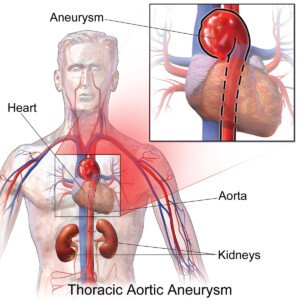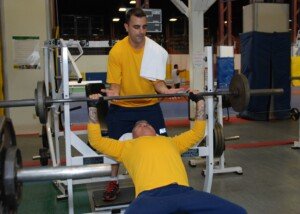
For those with thoracic aortic aneurysm, the restriction of “No straining” when lifting weights needs to be explained.
If you’ve been diagnosed with a thoracic aortic aneurysm and have always lifted weights, you’re likely wondering how to recognize that fuzzy boundary between a challenging workout and a “straining” workout.
Sometimes, straining is obvious, as in the case of a man barely getting a barbell off the floor in a deadlift, his back buckling, legs quivering, face turning red, and it seemingly takes him forever to straighten his back.
But straining doesn’t always look like this, either.
Lifting weights doesn’t have to be straining, so here are guidelines for distinguishing between straining and not straining.
There are five basic levels of lifting weights: 1) Going Through the Motions, 2) Some Work, 3) Challenging, 4) Difficult, and 5) Straining.
What’s the difference between Difficult and Straining?
- It’s not determined by amount of weight lifted.
- It’s determined by amount of effort.
One person’s straining load can be another person’s warm-up lift. As a former personal trainer, I’ve had clients straining with weight loads that others moved with little effort.
Signs of Straining
- Vocalizing or feeling like vocalizing
- Squirming or other substantial form breaks
- Grimacing
- Moving the load slowly because it’s so heavy, especially with pauses.
- Valsava maneuver
“Valsalva is what we do when lifting something very heavy and when we are bearing down to have a bowel movement,” says Michael Fiocco, MD, Chief of Open Heart Surgery at Union Memorial Hospital in Baltimore, Maryland, one of the nation’s top 50 heart hospitals..
Now, if you are not grunting, moaning or groaning, this does not mean you can’t be in the Straining zone.
The key is if you feel compelled to grunt or groan. You may be avoiding this simply out of courtesy to nearby people, but if you actually feel like doing it, then you’re straining — at least somewhat – a forbidden zone for thoracic aortic aneurysm.
What does Challenging mean?
A Challenging set of eight bench presses means that the tempo is a little slowed down at the seventh or eighth rep due to increasing fatigue, but you feel you can do another eight. You stop at only eight.

Turn the Challenging bench press into a Difficult set by lifting the same weight, but for 12 reps.
You stop at 12, but know you can do three or four more. Your arms “feel it,” but you aren’t “whupped” yet.
To make this a Straining set, add more weight so that you must struggle to complete four or five reps.
Form breaks are tempting at this stage, namely, arching the back. Or perhaps one arm is lagging behind the other and you’re gritting your teeth and scrunching up your eyes.
Often, an eight-rep max will make a person feel they must strain — depending on the move. Certainly, you’ll feel much more straining for an 8-RM deadlift, squat or bench press vs. a dumbbell curl.

BruceBlaus/CreativeCommons
Recap
Going Through the Motions: This is like warming up.
Some Work: Think of this as more than a warm-up, or what you might do when recovering from a mild injury.
Challenging: Minimal heart rate elevation; no or minimal increase in respiration; yet you feel worked.
Textbook form, and solid, rhythmic breathing are maintained throughout, but you also induced a little muscle burn.
The lifts can be done quickly with full range of motion. You could have done the 12 reps with 25 percent more weight. You made it look easy to the observer.
Difficult: You can do fast lifts at the beginning, but quickly find you can no longer go fast.
You must pay more attention to breathing to avoid any breaks in breathing, but form is intact. No desire to grunt, groan, moan or grimace.
But the weight did get heavy. By the time you think you’re closing in on the Straining zone, the set is over. Heart rate is up, but nothing significant. An observer knows you definitely were not warming up.
Straining: To the observer, and to yourself, you are struggling. The lifts are laborious and slow, and unsteady if it’s with dumbbells.
You must concentrate on breathing to avoid pauses in breathing. There may be eventual form breaks, such as arching your back while bench pressing.
If you’re not grunting or moaning, it’s out of courtesy to others. Your face shows “pain.” At the conclusion, you know you kicked some bad butt.
Lifting Weights with a Thoracic Aortic Aneurysm

Dr. Fiocco specializes in treating artery disease, valvular disease and aortic aneurysm. His heart care expertise has earned him recognition by Baltimore Magazine as a Top Doctor in 2010, 2011, 2013, 2016 and 2017.
 Lorra Garrick is a former personal trainer certified through the American Council on Exercise. At Bally Total Fitness she trained women and men of all ages for fat loss, muscle building, fitness and improved health.
Lorra Garrick is a former personal trainer certified through the American Council on Exercise. At Bally Total Fitness she trained women and men of all ages for fat loss, muscle building, fitness and improved health.
.









































